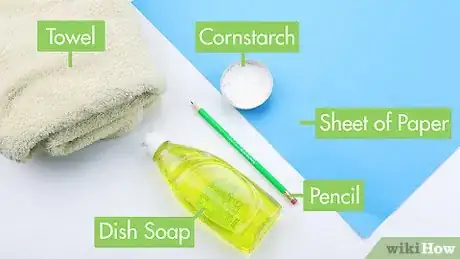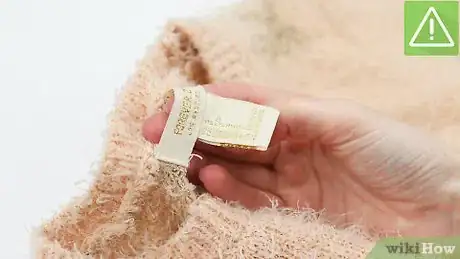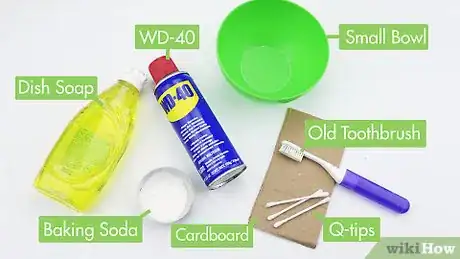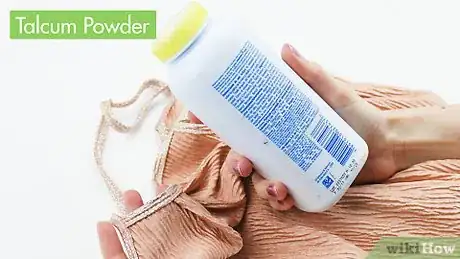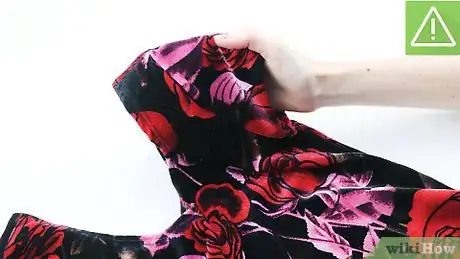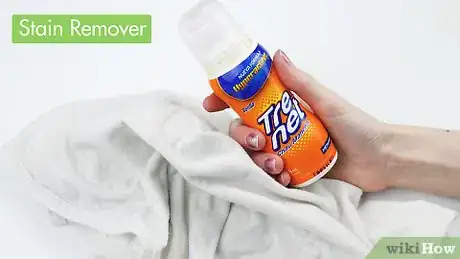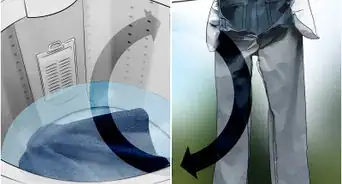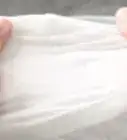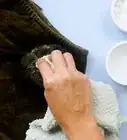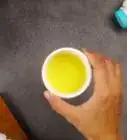This article was co-authored by Safir Ali. Safir Ali is the Co-Founder and CEO of Hamper Dry Cleaning and Laundry, a startup in Houston, Texas reinventing the laundry industry. With over six years of experience launching and operating Hamper, Safir specializes in innovative ways to simplify dry cleaning using the experience from his family's business. Safir holds a Bachelor’s degree in Business Administration and Management from Texas A&M University. Hamper offers 24/7 on-demand dry cleaning and laundry through delivery and kiosk services. Hamper has been featured on the Houston Rockets, Station Houston, the Houston Business Journal, BBVA, Yahoo Finance, and Innovation Map.
There are 11 references cited in this article, which can be found at the bottom of the page.
wikiHow marks an article as reader-approved once it receives enough positive feedback. In this case, 100% of readers who voted found the article helpful, earning it our reader-approved status.
This article has been viewed 2,876,836 times.
Oil stains may look terrible, but they are easy to remove. Even set-in stains are possible to remove, with a little bit of effort. This wikiHow will show you how to remove oil stains from different types of fabric, including wool.
Steps
Cotton, Rayon, Polyester, and Denim
-
1Gather your supplies. Oil stains will happen one time or another, whether you are frying something or eating a salad. Fortunately, they are simple to remove. Here is a list of what you will need:
- Paper towels
- Baking soda
- Old toothbrush
- Dish soap
-
2Blot the excess cooking oil out with a paper towel. Try to use a plain, white paper towel, or you will risk transferring dye to the garment.Advertisement
-
3Cover the stain with baking soda. You want a nice, thick layer. If you don't have any baking soda, try using some cornstarch instead.
-
4Let the baking soda sit for 30 to 60 minutes, then scrub it out with an old toothbrush. As you scrub the baking soda, you may see it starting to clump up. This is because the baking soda has absorbed the oil. The baking soda may even take on the color of the cooking oil.
- You will still have some baking soda residue left over. Don't worry. This is normal, and it will wash out.
- You may have to repeat the baking soda step for tough stains. Simply add more baking soda, wait another 30 to 60 minutes, then scrub it out.
-
5Pour some dish soap over the baking soda. Gently work the dish soap into the baking soda with your fingers.[1] You still want a thin layer of dish soap on the fabric. If the dish soap has soaked into the fabric, simply add more.
-
6Wash the garment in the washing machine.[2] Follow the instructions on the care tag. Hot water helps remove oil stains, but not everything can be washed in hot water.
- Try adding 1/2 to 1 cup (118 to 237 milliliters) of white vinegar to the wash cycle. This will make the detergent even more effective.
-
7Make sure that the stain is completely gone before you use the dryer. If the stain is still there when you put the garment into the dryer, you will risk setting the stain. Try to remove the stain again. If you can't, let the garment air dry, and take it to a professional dry cleaner.
Wool or Cashmere
-
1Gather your supplies. Hot water is ideal for removing stains from fabric, but it can destroy a sweater. Because of this, you will need to take extra steps to remove oil stains from sweaters. Here is a list of what you will need:[3]
- Cornstarch
- Dish soap
- Cold water
- Sink or tub
- Sheet of paper larger than the sweater
- Pencil or pen
- Large towel
-
2Start by covering the stain with cornstarch and brushing it off after 30 minutes. Repeat this two or three more times. Sometimes, this is all you need to remove the oil stain. If the stain persists, keep reading.
-
3Put the sweater down on the paper and trace it with a pencil or pen. You will be soaking the sweater in water, which could cause it to lose its shape. You will need to stretch the sweat back out to its original shape. This tracing will be your template for that step.
-
4Fill a sink with cold water. For a large, bulky sweater, try using a tub or large basin instead. The sweater will need to be completely submerged, so make sure that the water is deep enough.
-
5Add a few drops of dish soap into the water. Pass your hand through the water a few times to mix everything together. Do not agitate the water so much that you get frothy bubbles. The dish soap will help break up the stubborn stain, and remove it.
-
6Put the sweater into the water and gently swish it around. Do not wring or twist the sweater, or you may ruin the shape and fibers.
-
7Let the sweater sit for two to three minutes before pulling it out.[4] Again, resist the urge to wring or twist the sweater. Simply let the water drip out of it.
-
8Drain the dirty water and fill the sink with fresh water so that you can rinse the sweater. Keep draining the old water and soaking the sweater in fresh water until all the soap is gone, and the water is clear. You may need to do this about 10 to 12 times.[5]
-
9Dry the sweater by rolling it up in a large towel. Once the water is clear and the soap is gone, lift the sweater out of the sink and let the water drip out. Lay the sweater flat on one end of a large towel. Start rolling both the towel and sweater towards the other end like a Cinnabon or burrito. The towel will help soak up the excess water. Unroll the towel and take the sweater off.
-
10Put the sweater back onto the sheet of paper and stretch it until it's back to its original shape. Gently tug on the sleeves, hem, and sides, until everything matches up with the outline you drew earlier.
-
11Know how to handle other wool fabrics. If you got a woolen skirt, suit, or pants stained with oil, try using a solution made from 1 part dish soap, 1 part white vinegar, and 6 parts water. Cover the stain with the solution, and tap it gently with an old toothbrush. Wait a few minutes, then blot everything dry with a clean towel. Clean off any residue by tapping the area with a damp towel. Finish by dabbing the area dry with another dry towel.
- You may need to follow up with the washing instructions on the care tag. This means that you may need to take the sweater to a dry cleaner, hand wash it, or put it in the washing machine.
- Do not leave this solution for too long on the wool, or you may discolor the fabric.
Removing Set-in Stains
-
1Gather your supplies. Sometimes, you don't notice oil stains until after you have already washed and dried the garment. Unfortunately, the heat of the dryer would have set the stain into the fabric. Luckily, it is still possible to remove the stain. Here is a list of what you will need to do this:[6]
- Cardboard (recommended)
- WD-40
- Baking soda
- Dish soap
- Old toothbrush
- Small bowl and Q-tips (for small stains)
- Washing machine
-
2Put a piece of cardboard inside the garment, behind the stain. Try to cut the cardboard several times larger than the stain, in case the stain spreads. The cardboard will prevent the stain from sinking into the back of your garment.
-
3Spray the stain with some WD-40. If you have a small stain, spray the WD-40 into a small bowl, and apply it to the stain using a Q-tip. The WD-40 will help break the oil stain down and make it easier to get out.
-
4Use an old toothbrush to scrub some baking soda into the stain. Pour some baking soda over the stain and WD-40. You want a nice, thick layer. Work it into the fabric using a toothbrush. As you scrub, you will notice the baking soda clumping up. This is because the baking soda is absorbing the oil.
-
5Repeat the baking soda treatment until you have no more clumps. Dust off the old, clumpy baking soda, and sprinkle on some new baking soda. Keep scrubbing, dusting, and adding new baking soda until you get no more clumps.[7]
- You will probably end up with lots of white powder everywhere. Don't worry. This is normal. The baking soda will wash off.
-
6Pour some dish soap onto the baking soda. Gently swirl the dish soap so get it into the fabric. Make sure that there is still a slick layer of dish soap. If it has completely soaked into the fabric, add a little bit more.
-
7Wash the garment in the washing machine according to the tag. Do not rinse the dish soap off; it will come off in the washer.
-
8Make sure that the stain is gone before using the dryer. If the stain is still there, let the garment air-dry, and try the method again. You can also take the item to a dry cleaner. Only when the stain is gone is it safe to put it into the dryer. This is because the heat of the dryer can set the stain.
Trying Other Solutions
-
1Be gentle with delicate fabrics. Some fabrics, such as silk and chiffon, will not hold up well to harsh scrubbing and hot temperatures. Instead, cover the stain with baby powder, cornstarch, or talcum powder. Leave the garment in a dry, warm place for a few hours (overnight if necessary), then brush the powder away. Keep repeating this step until the powder no longer clumps up and the stain is gone.
-
2Know how to handle dry-clean-only fabrics. As their name suggests, dry-clean-only fabrics should not get wet. This means that you cannot use things like dish soap and water to remove the stain. Instead, sprinkle some baby powder, cornstarch, or talcum powder over the stain. Let it sit for a few moments, then brush it off. This may be enough to get the stain out. If the stain is still there, take the garment to the dry cleaner.
-
3Treat the stain with cornstarch and dish soap. Sprinkle some cornstarch over the stain and let it sit for 30 to 60 minutes. Pour some dish soap over the cornstarch and rub it in. Do not rinse the dish soap or cornstarch off. Instead, toss the garment into the washing machine, and was as usual according to the tag.[8]
- You can also try using cornmeal or cornstarch on its own, without the dish soap. The powder will help absorb the oil.[9]
-
4Use some hairspray to dissolve the stain. Simply cover the stain with some hair spray. Wash and dry the garment according to the care instructions on the tag. Hairspray contains alcohol, which will help loosen and dissolve the oil.[10]
-
5Try using hydrogen peroxide, baking soda, and dish soap. Soak the stain with some hydrogen peroxide, then sprinkle a thick layer baking soda over it. Cover the baking soda with some dish soap, and sprinkle on a light layer of more baking soda. Scrub the entire area with a toothbrush, then let it sit for 30 to 60 minutes. Do not rinse the treatment out. Instead, wash the garment as you normally would in the washing machine. Be sure to follow the instructions on the tag.[11]
- Hydrogen peroxide should not stain dark fabrics, but it may. If you are worried about this, it might be a good idea to test it out on an inconspicuous area, such as a hem or cuff.
-
6Use some aloe vera, dish soap, or shampoo as a pre-wash stain remover.[12] Blot any excess oil using a clean cloth or a paper towel. Then, squirt some aloe vera, dish soap, or shampoo onto the stain. Use an old toothbrush or a manicure brush to rub the stain into the fabric. Let the stain sit for a few minutes.[13] Don't rinse the aloe vera, dish soap, or shampoo off. Instead, toss the garment into the washer, and wash according to the instructions on the tag.[14]
-
7Try using a store-bought pre-wash stain remover. Start by blotting up the excess oil, then cover the stain with the stain remover. Wait 30 minutes, then wash the garment according to the tag.[15]
Expert Q&A
Did you know you can get expert answers for this article?
Unlock expert answers by supporting wikiHow
-
QuestionHow can I get dried oil out of clothes?
 Safir AliSafir Ali is the Co-Founder and CEO of Hamper Dry Cleaning and Laundry, a startup in Houston, Texas reinventing the laundry industry. With over six years of experience launching and operating Hamper, Safir specializes in innovative ways to simplify dry cleaning using the experience from his family's business. Safir holds a Bachelor’s degree in Business Administration and Management from Texas A&M University. Hamper offers 24/7 on-demand dry cleaning and laundry through delivery and kiosk services. Hamper has been featured on the Houston Rockets, Station Houston, the Houston Business Journal, BBVA, Yahoo Finance, and Innovation Map.
Safir AliSafir Ali is the Co-Founder and CEO of Hamper Dry Cleaning and Laundry, a startup in Houston, Texas reinventing the laundry industry. With over six years of experience launching and operating Hamper, Safir specializes in innovative ways to simplify dry cleaning using the experience from his family's business. Safir holds a Bachelor’s degree in Business Administration and Management from Texas A&M University. Hamper offers 24/7 on-demand dry cleaning and laundry through delivery and kiosk services. Hamper has been featured on the Houston Rockets, Station Houston, the Houston Business Journal, BBVA, Yahoo Finance, and Innovation Map.
Laundry Specialist
-
QuestionWhat removes grease stains at home?
 Safir AliSafir Ali is the Co-Founder and CEO of Hamper Dry Cleaning and Laundry, a startup in Houston, Texas reinventing the laundry industry. With over six years of experience launching and operating Hamper, Safir specializes in innovative ways to simplify dry cleaning using the experience from his family's business. Safir holds a Bachelor’s degree in Business Administration and Management from Texas A&M University. Hamper offers 24/7 on-demand dry cleaning and laundry through delivery and kiosk services. Hamper has been featured on the Houston Rockets, Station Houston, the Houston Business Journal, BBVA, Yahoo Finance, and Innovation Map.
Safir AliSafir Ali is the Co-Founder and CEO of Hamper Dry Cleaning and Laundry, a startup in Houston, Texas reinventing the laundry industry. With over six years of experience launching and operating Hamper, Safir specializes in innovative ways to simplify dry cleaning using the experience from his family's business. Safir holds a Bachelor’s degree in Business Administration and Management from Texas A&M University. Hamper offers 24/7 on-demand dry cleaning and laundry through delivery and kiosk services. Hamper has been featured on the Houston Rockets, Station Houston, the Houston Business Journal, BBVA, Yahoo Finance, and Innovation Map.
Laundry Specialist
-
QuestionCan I use cooking oil instead of WD-40?
 Community AnswerNo. Cooking or other types of oil are what you are trying to get out. WD-40 is a solvent and helps break down those oils.
Community AnswerNo. Cooking or other types of oil are what you are trying to get out. WD-40 is a solvent and helps break down those oils.
wikiHow Video: How to Get a Cooking Oil Stain out of Clothing
Warnings
- Not all fabrics can handle hot water, and not all fabrics can be washed. Always read the how-to-wash tag inside the garment.⧼thumbs_response⧽
- The heat from a dryer can set oil stains. Always make sure that the stain is completely gone before you toss the garment into the dryer. If you don't do this, the dryer will set the stain into the fabric.⧼thumbs_response⧽
- Dish soap can fade color from freshly-dyed fabric. It can also cause brand-new fabric to fade as well. Check the garment for color-fastness before using dish soap.⧼thumbs_response⧽
Things You'll Need
Things You'll Need for Regular Fabric
- Paper towels
- Baking soda
- Old toothbrush
- Dish soap
- Washing machine
Things You'll Need for Set-In Stains
- Cardboard (recommended)
- WD-40
- Baking soda
- Dish soap
- Old toothbrush
- Small bowl and Q-tips (for small stains)
- Washing machine
Things You'll Need for Wool and Sweaters
- Cornstarch
- Dish soap
- Cold water
- Sink or tub
- Sheet of paper larger than the sweater
- Pencil or pen
- Large towel
References
- ↑ Safir Ali. Professional Dry Cleaner. Expert Interview. 15 September 2020.
- ↑ Safir Ali. Professional Dry Cleaner. Expert Interview. 15 September 2020.
- ↑ How to Clean Stuff, How to Remove Olive Oil Stains from a Wool Sweater
- ↑ Safir Ali. Professional Dry Cleaner. Expert Interview. 15 September 2020.
- ↑ How to Clean Stuff, How to Remove Olive Oil Stains from a Wool Sweater
- ↑ https://diycozyhome.com/remove-oil-stains-from-clothing-with-this-diy-hack/
- ↑ https://www.youtube.com/watch?v=g64bggUFDGU
- ↑ Wise Bread, 14 Effective Grease and Oil Stain Removal Tips
- ↑ Mrs. Clean, Tips on Removing Oil Stains
- ↑ Wise Bread, 14 Effective Grease and Oil Stain Removal Tips
- ↑ One Good Thing by Jillee, Getting Oily Stains Out of Dark-Colored Fabric
- ↑ Wise Bread, 14 Effective Grease and Oil Stain Removal Tips
- ↑ Mrs. Clean, Tips on Removing Oil Stains
- ↑ The Kitchn, How to Remove Grease Stains
- ↑ Good Housekeeping, Stain Buster - Cooking Oil
- ↑ How to Clean Stuff, How to Remove Grease Stains
- Videos provided by essortment
About This Article
To get a fresh cooking oil stain out of your clothing, first blot the excess oil away with a dry cloth or napkin. Then, apply a few drops of liquid dishwashing detergent to loosen the oil stain, and rub it in gently. After 5 minutes, rinse the soap and oil off with warm water. Then, wash your clothing in the washing machine with hot water and laundry detergent. Let the item air-dry and check if the stain was successfully removed. If it’s gone, you're done! Otherwise, liberally apply baking soda or cornstach to the stain to absorb the remaining oil. After an hour, scrub the baking soda away with an old toothbrush. If oil is still present, add baking soda and let the item sit again. Once the oil is gone, put a thin layer of dish soap on the fabric and wash it in the washing machine. After your clothes air-dry, they should be clean and oil-free! Read on for advice on how to remove stains from wool sweaters and dry-clean-only fabrics!


